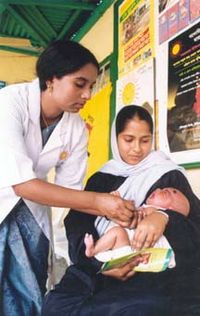
Photo from wikipedia
Background: Despite the stability of global vaccination coverage, over 19 million children worldwide do not currently receive basic vaccines. Over the past several years, there has been a dramatic drop… Click to show full abstract
Background: Despite the stability of global vaccination coverage, over 19 million children worldwide do not currently receive basic vaccines. Over the past several years, there has been a dramatic drop in the number of vaccinated children worldwide. The implementation of the vaccination program and the scope of protection depend on the parents or legal guardians, who decide whether to vaccinate their child or not. Studies were conducted to assess parents’ knowledge, attitudes, and beliefs about vaccines, as well as the role of healthcare providers in parents’ decisions. Methods: A population survey was conducted in 2018–2019. Parents or legal guardians of the children were invited to participate in the study during their visits to the clinic for healthy or sick children. The method used in the research was a diagnostic survey. Results: According to the conducted research, men and women constituted 45% and 55% of participants, respectively. The average age of men was 44, while, for women, it was 41. Internal research showed that as much as 71% of parents declared the need for vaccination, although 41% of parents vaccinated their children according to the vaccination calendar. The most frequently mentioned concerns included the possibility of adverse vaccination reactions (22%), the occurrence of autism (7%), and child death (6%). General practitioners had, by far, the greatest impact on the use of protective vaccination in children (73% women and 80% men), although there were cases of discouraging the performance of compulsory vaccinations (41%), and mentioning a doctor (38%) or nurse (3%). Conclusions: Modifiable determinants of the negative attitude toward vaccinations are caused mainly by the lack of knowledge. These obstacles in vaccinations can be overcome by improving health education in terms of the vaccination program.
Journal Title: International Journal of Environmental Research and Public Health
Year Published: 2020
Link to full text (if available)
Share on Social Media: Sign Up to like & get
recommendations!